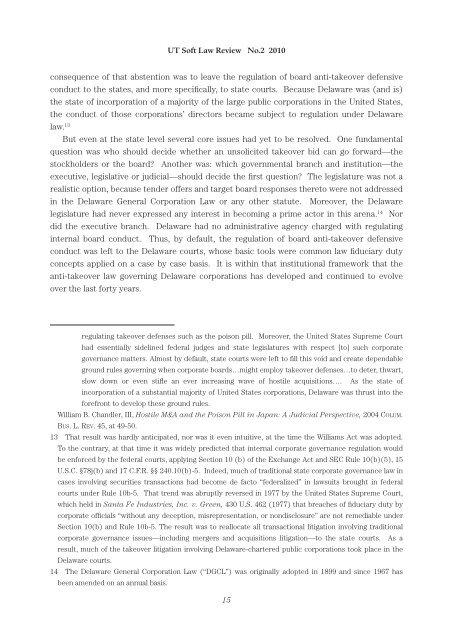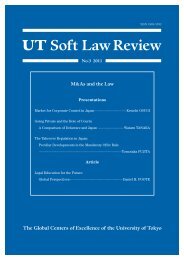UT Soft Law Review
UT Soft Law Review
UT Soft Law Review
You also want an ePaper? Increase the reach of your titles
YUMPU automatically turns print PDFs into web optimized ePapers that Google loves.
<strong>UT</strong> <strong>Soft</strong> <strong>Law</strong> <strong>Review</strong> No.2 2010consequence of that abstention was to leave the regulation of board anti-takeover defensiveconduct to the states, and more specifically, to state courts. Because Delaware was (and is)the state of incorporation of a majority of the large public corporations in the United States,the conduct of those corporations’ directors became subject to regulation under Delawarelaw. 13But even at the state level several core issues had yet to be resolved. One fundamentalquestion was who should decide whether an unsolicited takeover bid can go forward—thestockholders or the board? Another was: which governmental branch and institution—theexecutive, legislative or judicial—should decide the first question? The legislature was not arealistic option, because tender offers and target board responses thereto were not addressedin the Delaware General Corporation <strong>Law</strong> or any other statute. Moreover, the Delawarelegislature had never expressed any interest in becoming a prime actor in this arena. 14 Nordid the executive branch. Delaware had no administrative agency charged with regulatinginternal board conduct. Thus, by default, the regulation of board anti-takeover defensiveconduct was left to the Delaware courts, whose basic tools were common law fiduciary dutyconcepts applied on a case by case basis. It is within that institutional framework that theanti-takeover law governing Delaware corporations has developed and continued to evolveover the last forty years.regulating takeover defenses such as the poison pill. Moreover, the United States Supreme Courthad essentially sidelined federal judges and state legislatures with respect [to] such corporategovernance matters. Almost by default, state courts were left to fill this void and create dependableground rules governing when corporate boards…might employ takeover defenses…to deter, thwart,slow down or even stifle an ever increasing wave of hostile acquisitions…. As the state ofincorporation of a substantial majority of United States corporations, Delaware was thrust into theforefront to develop these ground rules.William B. Chandler, III, Hostile M&A and the Poison Pill in Japan: A Judicial Perspective, 2004 Colum.Bus. L. Rev. 45, at 49-50.13 That result was hardly anticipated, nor was it even intuitive, at the time the Williams Act was adopted.To the contrary, at that time it was widely predicted that internal corporate governance regulation wouldbe enforced by the federal courts, applying Section 10 (b) of the Exchange Act and SEC Rule 10(b)(5), 15U.S.C. §78j(b) and 17 C.F.R. §§ 240.10(b)-5. Indeed, much of traditional state corporate governance law incases involving securities transactions had become de facto “federalized” in lawsuits brought in federalcourts under Rule 10b-5. That trend was abruptly reversed in 1977 by the United States Supreme Court,which held in Santa Fe Industries, Inc. v. Green, 430 U.S. 462 (1977) that breaches of fiduciary duty bycorporate officials “without any deception, misrepresentation, or nondisclosure” are not remediable underSection 10(b) and Rule 10b-5. The result was to reallocate all transactional litigation involving traditionalcorporate governance issues—including mergers and acquisitions litigation—to the state courts. As aresult, much of the takeover litigation involving Delaware-chartered public corporations took place in theDelaware courts.14 The Delaware General Corporation <strong>Law</strong> (“DGCL”) was originally adopted in 1899 and since 1967 hasbeen amended on an annual basis.15





